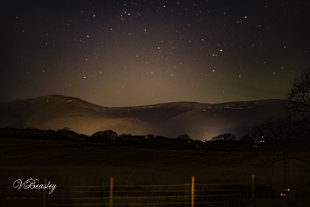March Newsletter
While winter is not over yet, it certainly feels like it. In the last two weeks, I’ve a couple of very productive days at Birnie and Gaddon Lochs and a great evening taking shots of the night sky.

This swan, at Birnie Loch, was almost too eager to have his photo taken; so much so, that he was pecking the camera to hurry me up.
On my second visit, I managed to bag another good shot of a solitary gull.

The image of the Ochils that I chose from the night time shots turned out very well. The way that I achieved the clarity in it, was to use the Dehaze slider in my editing software. This more than doubled the number of stars that became visible and is definitely something that I would recommend when shooting stars.

The lights from the Hillfoots villages highlight the hills beautifully.
Just like everyone else who works, I only have small windows of opportunity to actually go out and practice my photography. My method of getting out with a camera, is to have one with me when I walk the dogs. This can lead to some interesting shots, such as the two below. Both of these were taken with a totally inappropriate lens for the type of shot. I had a 150 -600mm wildlife zoom lens on simply because I have recently seen a owl hunting in the fields where we walk and the shots that I have taken should need a much shorter lens which has a much wider angle. However, that was what I had and I didn’t want to miss the shots.


In both of these images, the thing that really caught my eye, was the play of the sunlight on and in the grass. In the first image I have used a very shallow depth of field, to the extent that only one of the grass heads is truly in focus. However, this has created the separation from the background that I wanted to achieve, thereby making the subject, (the grass heads), stand out.
In the second image I have done the opposite and created a much wider depth of field, using the field, the blurred trees and the blown-out sun to draw the eye to the foreground and the sunlit grass. If you think about the way this image works, you will realise that the sun in the top left corner has been left so bright, that it pushes your eye away, because it is uncomfortable to look at.
As you can see, I have not stuck to any particular subject, but have captured shots as they came up. My previous suggestions about planning your shoot and then going out and making it happen, still holds good. However, taking your camera, coming across potential shots and creating successful images from them is really good practice for the times when you can plan your shoot. It can also be great fun, such as when you kneel down to take the grass heads shot and the dogs mug you because they think it’s a great game. That shot took five attempts and me lying on my camera to stop the two mad animals from jumping all over it.
The moral being, take your camera out whenever you can and practice with any subject from a snail to the moon and everything in between. The more mistakes that you make, the better you will get.
As Thomas Eddison said after 10000 attempts at making a light bulb, “I have just found 10000 ways not to do it”. We are lucky, we can find 10000 ways not to take a photograph, at no cost.
Is the following photograph one of those 10000 ways NOT to take a photograph?
I’ll leave you to decide!

